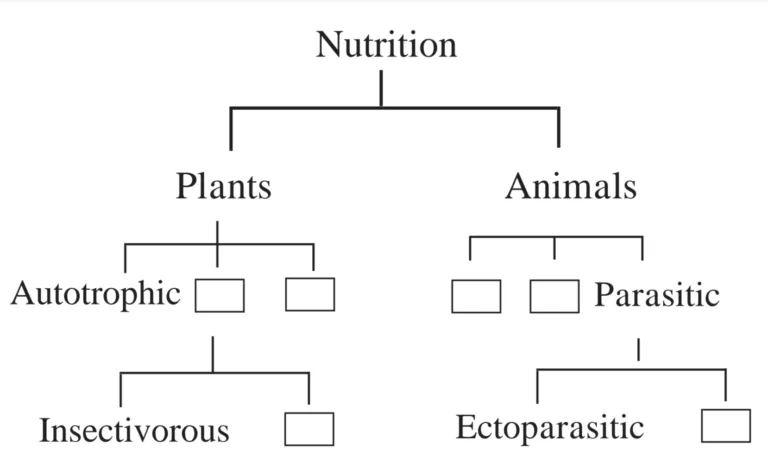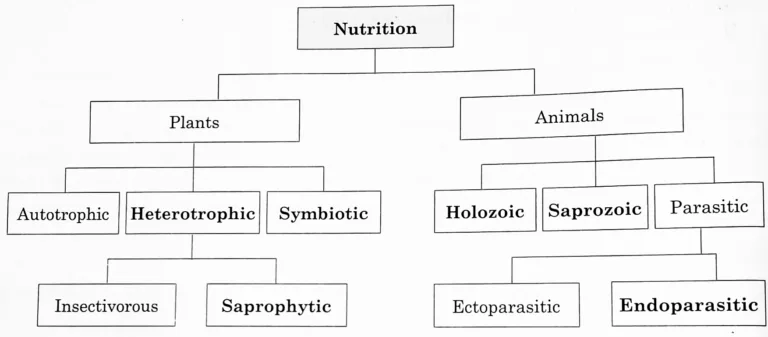Chapter 4 - Nutrition in Living Organisms
1. Classify according to food-type.
tiger, cow, vulture, bacteria, deer, goat, human, fungus, lion, sparrow, buffalo, frog, cockroach, tick.
Ans:
Herbivores:
Cow, Deer, Goat, Buffalo
Carnivores:
Tiger, Lion, Frog
Omnivores:
Sparrow, Human, Cockroach
Scavengers:
Vulture
Decomposers/Saprotrophic:
Bacteria, Fungus
Parasitic:
Tick
2. Match the pairs.
Group ‘A’
(1) Parasitic plant
(2) Insectivorous plant
(3) Saprophytic plant
(4) Symbiotic plant
Group ‘B’
(a) Mushroom
(b) Lichen
(c) Drosera
(d) Cuscuta
Ans:
Group ‘A’
(1) Parasitic plant
(2) Insectivorous plant
(3) Saprophytic plant
(4) Symbiotic plant
Group ‘B’
(d) Cuscuta
(c) Drosera
(a) Mushroom
(b) Lichen
3. Answer the following questions in your own words.
(a) Why do living organisms need nutrition?
Ans: Living organisms need nutrition for the following reasons:
(i) To supply the energy required for carrying out different activities.
(ii) For proper growth and development of the body.
(iii) To replace the damaged cells and repair tissues.
(iv) To fight against diseases.
(b) Explain the process of production of food in plants.
Ans:
(i) The plants produce their own food through the process of photosynthesis.
(ii) With the help of sunlight and chlorophyll, plants make their food in their leaves.
(iii) Also, they use water, nutrients from soil, and carbon dioxide from the air.
(iv) Thus, plants convert light energy into chemical energy and store it in the form of food.
(v) Chemical reaction of photosynthesis:

(c) What is meant by parasitic plants? Name their different types with examples of each.
Ans:
(i) The plants that depend on other plants for their food are called parasitic plants.
(ii) The parasitic plants are heterotrophic in their mode of nutrition. Some of them lack chlorophyll and thus cannot perform photosynthesis on their own.
(iii) Two types of parasitic plants are:
(a) Completely parasitic plants
For example: Cuscuta, Dodder, etc.
(b) Partially parasitic plants
For example: Loranthus, etc.
(d) Explain the various steps of nutrition in animals.
Ans: The steps of nutrition in animals are as follows:
(i) Ingestion: Feeding means ingestion. Food is taken into the body through ingestion.
(ii) Digestion: Different enzymes act on the complex food constituents and convert them into soluble nutrients. This process takes place at different places in the alimentary canal.
(iii) Absorption: The digested soluble nutrients are absorbed in the blood.
(iv) Assimilation: The nutrients are taken to each cell and tissue through the blood circulation. In the cells, energy is produced using these nutrients. Once the energy is released, the food is said to be assimilated.
(v) Egestion: The matter that is not digested and absorbed is thrown out of the body in the last step of egestion.
(e) Name some unicellular organisms in which all life-processes take place within their unicellular body.
Ans: Amoeba, Paramoecium and Euglena are the unicellular organisms in which
all the life processes take place within a single cell.
4. Give reasons.
(a) Insectivorous plants are attractively coloured.
Ans:
(i) Insectivorous plants feed on insects.
(ii) They need to capture the insects.
(iii) In order to attract these insects towards the plant, they are attractively coloured.
(b) Butterflies have a long tube-like proboscis.
Ans:
(i) Every insect is provided with mouth parts for ingestion.
(ii) It feeds on nectar and pollen from the flowers.
(iii) It thus has a tube-like proboscis to suck this food from the flower.
5. Prepare and complete the flowchart according to type of nutrition.

Ans:

6. Think and answer.
(a) We prepare a variety of foodstuffs and dishes at home. Are we then autotrophic organisms?
Ans: No, We are not autotrophic; we are heterotrophic organisms. It is because we do not have chlorophyll and we cannot make our own food using sunlight. We depend on plants for grains, pulses, and vegetables. We depend on animals for meat and eggs. Thus, we are dependent on plants and animals for food.
(b) Which organisms are greater in number – autotrophs or heterotrophs? Why?
Ans: Autotrophs are greater in number. It is because autotrophs have chlorophyll, so they can make their own food through photosynthesis. They do not depend on other animals for their nutrition and survival.
(c) The number of heterotrophs found in desert regions is smaller. However, they are found in greater numbers in the sea. Why is this so?
Ans:
(i) In desert regions, the autotrophs are lesser in number, as are the heterotrophs dependent on them. The food is scarce; therefore, the number of heterotrophs also reduces.
(ii) In oceans and seas, there are multitudes of zooplankton and phytoplankton. Phytoplankton are very small, microscopic floating plants that we may not see. The food chain in the sea is dependent on these planktonic species.
(iii) Therefore, the number of heterotrophs found in desert regions is smaller, but they are found in greater numbers in the sea.
(d) What damage or harm do ectoparasitic and endoparasitic animals cause?
Ans:
(i) Parasitic organisms depend on other animals for nutrition.
(ii) Ectoparasites live on the body surface of animals and may cause intense itching, thus damaging the skin. Sucking of blood by endoparasites may lead to blood loss in animals.
For example: louse, bedbug, tick, etc.
(iii) Endoparasites live inside the bodies of other animals and may cause digestive problems in animals.
For example: tapeworms, roundworms, etc.
(e) Why is plant food not produced in any other parts of the plant except the green ones?
Ans: The chlorophyll is present only in the green parts of the plants. In these parts, photosynthesis takes place. This produces food. The non-green parts do not produce food due to a lack of chlorophyll.
